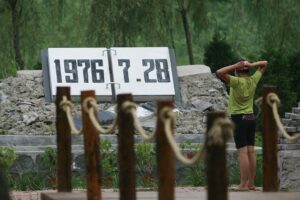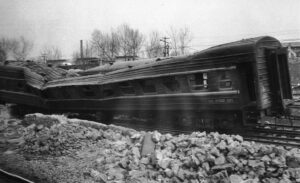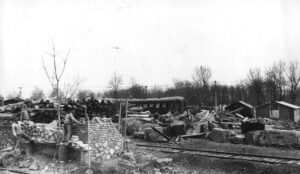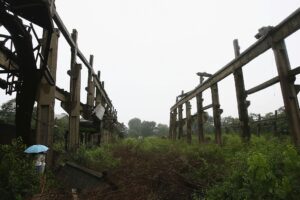
The Great Tangshan Earthquake: One of the worst earthquakes in modern history destroys Chinese city

![]() Caught between the Indian and Pacific plates, China has been a very active location for earthquakes throughout history, playing a significant part in China’s culture and science — in fact, the Chinese were the first to develop functioning seismometers.
Caught between the Indian and Pacific plates, China has been a very active location for earthquakes throughout history, playing a significant part in China’s culture and science — in fact, the Chinese were the first to develop functioning seismometers.
Located in a seismically active area, China has had many catastrophic earthquakes, including the 1556 Shaanxi Earthquake — considered the deadliest earthquake in recorded history — which killed an estimated 830,000 people on the morning of Jan. 23, 1556, in Shaanxi, China, during the Ming dynasty. China also tops the list of the world’s most earthquake-prone countries, according to World Atlas, with 157 earthquakes of significant magnitude between 1900 to 2016.
In the 20th century, more than 800 earthquakes of more than magnitude 6.0 have happened in China. Coincidentally, the deadliest earthquake of the 20th century happened at 3:42 a.m. on July 28, 1976, striking the Chinese industrial city of Tangshan (with a population of about one million people) in the People’s Republic of China. The catastrophic earthquake, measuring between 7.8 and 8.2 magnitude on the Richter scale (the maximum intensity of the earthquake was XI [Extreme] on the Mercali scale), obliterated the city of Tangshan and killed an estimated 240,000 people in the city and surrounding areas. There is speculation that the death toll from the quake was much higher than the official Chinese government figure of 242,000; some Chinese sources have spoken privately of more than 500,000 deaths or about one-half of the city’s inhabitants. Regardless, as almost everyone was asleep in their beds, instead of outside in the relative safety of the streets, the quake was especially costly in terms of human life.
Nature and wildlife give warning
Though scientific earthquake prediction is in its nascent stages, nature often gives some advance warning of an impending earthquake. Media reports have said people had begun noticing strange phenomena in and around Tangshan, several days before the earthquake.
In a village outside of Tangshan, well water reportedly rose and fell three times the day before the earthquake. In another village, gas began to spout out of the water well during the start of the month and then increased three days before the quake. Other wells throughout the area showed signs of cracking. During the night preceding the quake, many people reported seeing strange lights as well as loud sounds. The lights were seen in a multitude of hues. Some people saw flashes of light; others witnessed fireballs flying across the sky. Loud, roaring noises followed the lights and fireballs. Workers at the Tangshan airport described the noises as louder than that of an airplane.
Animals also gave warning that something was about to happen. The Tangshan earthquake was preceded by more than 2,000 reported animal anomalies, some of which were very dramatic in nature. Thousands of chickens refused to eat and ran around excitedly. Hundreds of mice and yellow fire weasels were seen running and looking for a place to hide. Horses, cattle and donkeys were frightened, refused to enter their stables, and did not eat. Also, pigs and sheep refused to enter their pens, and if already in them, tried to break out. Dogs barked in an exited way and evacuated pups from the houses, carrying them in their mouths. Cats were restless and woke up their owners. Rabbits refused to eat, made strange high-pitched noises, and attempted to leave their pens. It was found that the unusual animal behavior before the Tangshan quake was targeted in the areas where the critical fault lines were concentrated.
The earthquake strikes

With most people sleeping quietly when the earthquake struck, at least a quarter-of-a-million people were killed and 160,000 others injured. As the earth began to shake, some people who were awake had the forethought to dive under a table or other heavy piece of furniture, but most were asleep and did not have time. The initial 7.8 to 8.2 magnitude quake lasted for 23 seconds and leveled 90 percent of Tangshan’s buildings. It came during the heat of midsummer, and once the quake was over many stunned survivors scrambled out into the open naked, covered only in dust and blood, to see the entire city leveled.
The earthquake caused the failures of the electric power system, the water supply system, the sewer system, the telephone and telegraph systems, and radio communications; and the large coal mines and the industries dependent on coal were devastated. Forty earth dams were damaged, including one 217 feet high and 315 feet long, but there was no severe flooding. The earthquake also started several fire incidents and ignited explosives. Several of Tangshan’s factories and plants were leaking poisonous gases. The medical centers were destroyed, as were 300 miles of railway track and the 20 highway bridges to get there so that the city was isolated from the external world.
Two special effects of the quake, crater formation and “sand blows,” were reported by the Chinese. Some craters were large enough to swallow a house and may have formed over previously unknown limestone caverns. Sand blows are geysers of sand that erupt where an underlying sand layer is subject to squeezing. They were observed during the New Madrid earthquake in the Mississippi valley early in the last century. Some sand blows around Tangshan reached a height of 10 feet and continued for several hours. They were so voluminous that irrigation canals were blocked and farmland was buried.
Aftershocks and aftermath

After an initial period of shock, the survivors began to dig through debris to answer the muffled calls for help as well as to find missing loved ones. As injured people were saved from under the rubble, they were placed on the side of the road. Though 80 percent of the people trapped under debris were saved, a second 7.1 magnitude mainshock struck that afternoon near Luanxian, just south of the northeastern end of the Tangshan fault, and sealed the fate of many who had been waiting under the rubble for help.
Following the second mainshock, a long sequence of aftershocks followed just three and a half hours after the initial shock, with 12 tremors measuring 6.0 magnitude or greater. Immediately afterward, 242,419 people lay dead or dying, along with another 164,581 people who were severely injured. In 7,218 households, all members of the family were killed by the earthquake. More than 160,000 families were left homeless, and more than 4,000 children were orphaned. Many experts have suggested that the official loss of life was underestimated and that it is likely that closer to 700,000 people died.
Corpses were buried quickly, close to the residences in which they perished. This later caused health problems, especially after it rained and the bodies were again exposed. Workers had to find these impromptu graves, dig up the bodies, and then move and rebury the corpses outside of the city.
Damage, recovery, rebuilding and research
Before the 1976 earthquake, Chinese scientists didn’t think Tangshan was susceptible to a large earthquake and the area was zoned at an intensity level of VI on the Chinese intensity scale (similar to the Mercalli scale based on observable earthquake damage). The initial 7.8 earthquake that hit Tangshan was given an intensity level of XI (out of XII). Not surprisingly, the buildings in Tangshan were not built to withstand such a large earthquake.
The quake either partially destroyed — or so seriously damaged as to be unusable — more than 85 percent of unreinforced houses, multistory buildings and other structures in Tangshan. Ninety-three percent of residential buildings and 78 percent of industrial buildings were completely destroyed. Eighty percent of the water-pumping stations were seriously damaged and the water pipes were damaged throughout the city; 14 percent of the sewage pipes were severely damaged.
Of the 352 multi-story brick buildings in Tangshan, 117 collapsed completely, 85 collapsed in part and 99 were severely damaged. Only four were unharmed. Photographs show concrete floors heaped layer upon layer as though the walls had evaporated. The earthquakes also produced spectacular examples of liquefaction damages. Failures of slope, foundations of buildings and bridges were noticed. Some of the buried structures were observed floating at ground level after the earthquake.

Chinese engineers attribute the widespread building collapse to unreinforced construction and many buildings with low seismic resistance. Although the building code in effect at the time had seismic design requirements, Tangshan was in a zone requiring no earthquake design. An earthquake disaster requires a large earthquake efficiently close to a large city to produce destructive ground shaking, and that the city has buildings not designed to resist earthquakes. The Tangshan disaster met all these requirements and the result was the greatest earthquake disaster in the history of the world.
China’s exposure to earthquakes has dramatically increased since 1990, researchers from Beijing Normal University have found. A 2002 report by the California Institute of Technology — The Great Tangshan Earthquake of 1976 — shows what can happen when an unexpected earthquake strikes an unprepared city and it makes clear the need for earthquake preparedness even if the probability of an earthquake is assumed to be low.
Tangshan was eventually rebuilt with adequate earthquake precautions. Since the 1976 earthquake, Beijing has adopted building codes that analysts say are no less stringent than those in place in California and Japan. The current seismic regulations contain detailed requirements for practically every type of structure, from one-story playhouses to multi-level apartments made of mud, wood and stone. And many high-rise buildings in Chengdu have earthquake dampers — internal pendulums with heavy weights that damp movement in a quake.
The rebuilding of Tangshan began almost immediately and today, nearly two million people live there. Though it took time, the entire city was rebuilt and has earned Tangshan the nickname “Brave City of China.”






